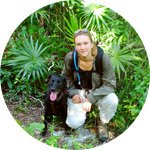About This Project
The goal of our project is to improve connectivity of jaguar habitat in southern Mexico, an area of highly threatened rainforest and a critical wildlife movement corridor. Our methods are completely noninvasive. Conservation Canines detection dogs locate scat samples for DNA/hormone analyses. Our goal will improve jaguar welfare and the ecosystem beneath this top predator, as well as the human societies that live alongside them.Ask the Scientists
Join The DiscussionWhat is the context of this research?
Our research seeks to understand how large mammal species interact with their environment, particularly within human-altered landscapes. In order to achieve this goal we need to know where they are, which features (e.g. villages or water) affect their movement behavior and physiology, and to what extent.
We gather this information from molecular analysis of scat samples. Scat offers a treasure trove of biological information (Lab Note: “Scat = Scientific Gold”), and is a completely noninvasive. Our Center for Conservation Biology pioneered many methods for using scat in wildlife research.
By combining data on resource selection, gene flow, and hormone levels, we get a holistic picture of how these animals interact with their environment, thereby aiding conservation.
What is the significance of this project?
Jaguar habitat is vanishing at an alarming rate - converted to agriculture or ranch-land. As forests shrink and become isolated from each other, jaguars are forced to migrate through areas of human activity and may be forced to seek prey elsewhere, such as livestock.
Human-wildlife conflicts lead to increased poaching and even poisoning of jaguars. The loss of top predators can cause a cascade of negative effects through the ecosystem. Our project will inform conservation initiatives as to how we can modify land use in order to sustain and live along side these animals.
Our project will be the first comprehensive study the populations of jaguars at our field site in southern Mexico, which has never been studied before due to their remoteness, terrain ruggedness, and dense vegetation.
What are the goals of the project?
- 3 Month Jaguar Scat Survey –previously unstudied site
- Confirm sample species ID via mtDNA sequencing
- Identify individuals via nuclear microsatellite genotyping
- Quantify T3 thyroid and glucocorticoid stress hormones
- Quantify population genetic and landscape genetic patterns
- Analyze Resource Selection Probability Functions
- Produce a connectivity map for southern Mexico
- Identify migration pinch-point locations for conservation
- Identify landscape features that could be modified for habitat improvement
- Dissemination of findings to local government and community organizations
- Publication of findings in peer-reviewed academic journals (open source if appropriate)
Budget
Our budget goal will provide matching-funds to a recently awarded $10,000 grant from the Animal Welfare Institute. AWI seeks the "better treatment of animals everywhere - in the laboratory, on the farm, in commerce, at home, and in the wild."
The majority of the funding raised here will be used to hire a senior-level dog/handler team from Conservation Canines to survey for jaguar scat over two months in southern Mexico. A smaller portion will be used for purchase of laboratory supplies for the genetic and endocrine analysis of the scat samples. Conservation Canines have aided scientists monitoring of many threatened wildlife species around the globe, including wolf and caribou in the Alberta Canada Oil Sands, grizzly bears in MT, and even killer whales in the Pacific Northwest!
Our stretch goal would allow us to hire a second dog/handler team, covering twice as much ground, gathering twice as many scats, and expanding our area of jaguar conservation activity.
Meet the Team
Team Bio
I’ve pursued a career in wildlife ecology ever since I studied the nocturnal behavior of juvenile dwarf caimans during a study-abroad in Ecuador. Sitting alone through the unnerving sounds of the jungle at night, using a flashlight to note the activity (or usually, the lack-thereof) of a 10" long caiman, battling clouds of giant mosquitoes, all I could think of was “this is the coolest thing I’ve ever done.”Following graduation I worked for five years as a wandering field technician on projects ranging from herpetology in SC, to plant biodiversity in MN, to tracking ocelots in Belize. Our proposed project is a culmination of my growing interest in large carnivore conservation science and noninvasive genetic methods. I have a strong interest in undergraduate education and bringing STEM opportunities to young women.
Outside of science, I enjoy camping in my Syncro, excursions with the Young Naturalists’ Society of the Pacific Northwest, microbrews, and hot-pickin’ bluegrass.
Additional Information
Conservation Canine, Scooby, gets his reward from Jennifer for a successful scat find - play time!
Jennifer takes samples from the scat ....
... and then processes them back at camp. Back at the Center for conservation Biology at the University of Washington, these samples will tell us all about the jaguars that live in this jungle.
Project Backers
- 149Backers
- 102%Funded
- $10,246Total Donations
- $64.62Average Donation
